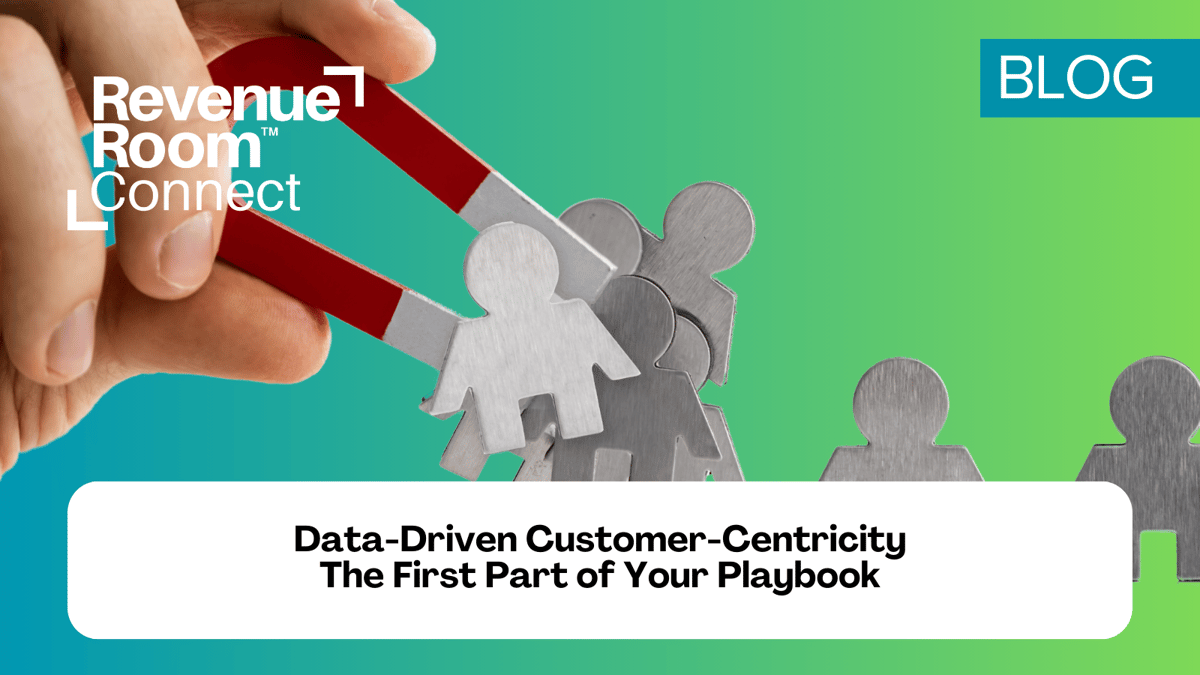Customer-Centricity
March 25, 2025
Unlocking Enterprise Value through Data-Driven Customer Centricity

# Data
# Customer-Centricity
# Events
# Media
# Operations
# Customer Experience (CX)
# Technology
# Sales Strategy
# Revenue
# Analytics
# Workforce & Culture
Leveraging enterprise value for sustainable growth

Heather Holst-Knudsen

Unlocking Enterprise Value through Data-Driven Customer Centricity
Understanding and leveraging enterprise value is crucial for sustainable growth in today's complex business landscape. As I recently discussed in our new rapid learning format for C-Suite executives, LunchLab, enterprise value goes far beyond just revenue and profitability. It encompasses customer retention, market positioning, operational efficiency, innovation, financial management, scalability, strategic partnerships, and risk management.
However, two critical elements underpin all these components: customer-centricity and data activation.
The Impact of Customer-Centricity on the Bottom Line
The statistics below underscore the significant impact of a customer-centric approach on a business's bottom line. This approach can drive enhanced profitability, increased customer lifetime value, and improved retention rates. It is evident that prioritizing customer experience and catering to customer needs can yield substantial business advantages.
When analyzing businesses that derive revenue from diverse sectors like media, events, and data/information, these statistics make a very compelling business case for investing in cultivating a customer-centric business model.
Profitability
- Customer-centric companies are 60% more profitable than companies that are not focused on the customer (Deloitte)
- Companies that lead in customer experience outperform laggards by nearly 80% (Forrester)
- 84% of companies that work to improve their customer experience report an increase in their revenue (Dimension Data)
Customer Lifetime Value (CLV):
- A 5% increase in customer retention can increase company revenue by 25-95% (Harvard Business Review)
- Loyal customers are worth up to 10 times as much as their first purchase (White House Office of Consumer Affairs)
- The probability of selling to an existing customer is 60-70%, while the probability of selling to a new prospect is only 5-20% (Marketing Metrics)
Retention
- It costs 5-25 times more to acquire a new customer than it does to retain an existing one (Harvard Business Review)
- Increasing customer retention rates by 5% increases profits by 25% to 95% (Bain & Company)
- 89% of companies see customer experience as a key factor in driving customer loyalty and retention (Gartner)
The Multi-Faceted Nature of Customer Centricity
Customer-centricity is not just a buzzword; it's a comprehensive approach that touches every aspect of your business. Here are key elements to consider:
Mindset: Deliver value in every customer interaction. This element is about adopting a customer-first mentality across your entire organization. It means viewing every touchpoint - from marketing emails to customer service calls - as an opportunity to provide value to the customer. For example, in marketing, aim for a 75/25 split: 75% of your communications should deliver valuable content to customers, while only 25% should be promotional. This approach builds trust and demonstrates your commitment to the customer's success, not just your bottom line.
Personalization and Relevance
Use data to understand and meet customer needs. True personalization goes beyond simply addressing a customer by name. It's about leveraging data to understand customer behaviors, preferences, and needs, then tailoring your offerings and communications accordingly. This could involve using predictive analytics to anticipate customer needs, or segmenting your audience for more targeted messaging. The key is relevance - providing customers with what they need, when they need it, based on data-driven insights.
Empathy
Provide holistic solutions by understanding customers' ultimate goals. Empathy in business means looking beyond your product or service to understand the broader context of your customer's challenges and objectives. It involves deeply understanding your customer's industry, business model, and long-term goals. With this knowledge, you can position your offerings as part of a holistic solution that addresses their underlying needs, not just as a standalone product or service.
Relationship Focus: Prioritize customer retention over constant acquisition. While acquiring new customers is important, retaining and growing relationships with existing customers often provides a better return on investment. This approach involves viewing each customer relationship as a long-term partnership. Focus on customer lifecycle management, proactively addressing issues, and finding new ways to add value. This can increase customer loyalty, higher lifetime value, and more stable, predictable revenue.
Organizational Alignment
Ensure clear roles and responsibilities internally. internally Customer centricity requires every department to work in harmony towards the common goal of customer success. This means clearly defining roles and responsibilities, ensuring smooth handoffs between departments, and breaking down silos that might impede the customer experience. For instance, sales, marketing, and customer success teams should have aligned goals and regular communication to ensure a seamless customer journey.
Holistic Approach
Involve leadership in customer engagement. Customer centricity must be championed from the top down. When C-suite executives regularly engage with customers - through site visits, feedback sessions, or even tracking key customer metrics - it sends a powerful message about the company's priorities. This high-level engagement also provides valuable insights that can shape company strategy and ensure that customer needs remain at the forefront of decision-making.
The Complexity of Multi-Sided Business Models
Certainly! Let's dive deeper into each of these challenges faced by multi-sided business models when implementing customer-centricity:
Diverse Stakeholders
Balancing the needs of different customer groups
Multi-sided business models often serve multiple distinct customer groups simultaneously. For example, a trade show organizer must cater to exhibitors, attendees, and sponsors. Each group has different needs and expectations, which can sometimes conflict. The challenge lies in creating value for all parties without significantly compromising the experience of any one group. This requires careful planning, clear communication, and often creative solutions to ensure all stakeholders feel their needs are being met.
Competing Interests
Managing various programs and initiatives simultaneously
In multi-sided models, different initiatives often compete for resources and attention. For instance, at a conference, you might have booth exhibitions, conference sessions, and hosted buyer programs all running concurrently. Each of these needs to succeed for different stakeholders, but they may compete for attendee time and attention. The challenge is to structure these programs in a way that maximizes value for all parties, perhaps by careful scheduling, creating synergies between programs, or using data to optimize the overall experience.
Data Integration
Consolidating customer data from multiple systems and acquisitions
Multi-sided businesses often use numerous systems to manage different aspects of their operations - CRM systems, event management platforms, marketing automation tools, etc. Additionally, they may accumulate multiple systems serving similar functions through acquisitions or organic growth. The challenge is integrating data from all these sources to create a unified view of each customer. This is crucial for delivering personalized experiences and making informed business decisions, but it requires significant technical expertise and often substantial investment.
Internal Priorities
Aligning incentives and KPIs across departments
Different departments within a multi-sided business may have misaligned incentives that can undermine customer-centricity. For example, a marketing team might be incentivized to maximize event registrations, while sales teams are focused on sponsor satisfaction which is directly connected to attendee quality and engagement. This can lead to situations where quantitative goals are met (high attendance) but qualitative goals suffer (sponsor ROI). The challenge is to create a balanced scorecard of KPIs that encourages all departments to work towards overall customer satisfaction and business success.
Channel Diversification
Managing diverse revenue streams and contracts
Multi-sided businesses often have complex revenue models with multiple streams - subscriptions, advertising, sponsorships, ticket sales, etc. These may have different contract structures, revenue recognition rules, and customer success metrics. The challenge is to manage this complexity while still providing a cohesive and satisfying customer experience. This often requires sophisticated financial management and customer success strategies tailored to each revenue stream.
Compliance
Ensuring data governance and hygiene
The growing significance of data in advancing customer-centricity necessitates that multi-sided businesses navigate intricate data governance terrains. This involves adhering to regulations such as GDPR or CCPA, upholding data quality across diverse systems, and enforcing robust data security protocols. The complexity is amplified in multi-sided models due to the varied data types gathered from distinct stakeholder groups. Ensuring meticulous data hygiene and governance is imperative for regulatory adherence upholding customer trust, and facilitating efficient data-driven strategies. The intricacy is heightened in multi-sided models due to the diverse data collected from various stakeholder groups. Upholding meticulous data hygiene and governance is essential for regulatory conformity fostering customer trust, and empowering effective data-driven decision-making. Hygiene and governance are pivotal in generating the necessary insights to steer successful customer-centric approaches.
Addressing these challenges requires a strategic approach considering multi-sided business models' unique dynamics. It often involves investing in robust technology solutions, fostering a culture of customer-centricity across the organization, and continuously refining processes based on stakeholder feedback and data insights. While complex, successfully navigating these challenges can lead to a strong competitive advantage and enhanced value for all stakeholders in the ecosystem.
Overcoming Challenges in Customer Centricity
While the benefits of customer centricity are clear, implementing and maintaining this approach comes with its challenges. Understanding and addressing these obstacles is crucial for organizations aiming to put the customer at the center of their operations.
Avoid "boiling the ocean" - focus on manageable, impactful initiatives
One common pitfall is trying to transform everything at once. This approach can lead to being overwhelmed and having ineffective implementation. Instead, organizations should identify key touchpoints in the customer journey where improvements can have the most significant impact. Start with pilot projects that can demonstrate quick wins and build momentum. For example, focus on enhancing sponsor onboarding, post-event engagement, and upsell processes or improving response times in customer support before tackling larger, more complex initiatives.
Ensure consistency between claims and actions, starting from top leadership
Customer centricity must be more than just a slogan - it needs to be embedded in the company's culture and actions. This alignment starts at the top. Leadership must advocate for customer-centric practices and embody them in their decision-making and interactions. Regular training and communication can help employees understand and embrace the customer-centric approach. Customer-centric KPIs need to be part of dashboards and management meeting discussions. Consider implementing reward systems that recognize and incentivize customer-centric behaviors across all levels of the organization.
Balance customer focus with business profitability
While putting customers first is important, it shouldn't come at the expense of business sustainability. The challenge lies in finding the sweet spot where customer needs are met while maintaining profitability. This might involve making tough decisions, such as discontinuing unprofitable products or services that some customers love. The key is communicating transparently with customers about such decisions and always striving to offer alternatives or solutions that still meet their needs.
Implement proper processes to support customer-centric initiatives
Customer centricity requires more than just good intentions - it needs to be supported by robust processes and systems. This includes:
- Implementing comprehensive customer feedback systems
- Developing data analytics capabilities to gain deeper customer insights
- Creating cross-functional teams to address customer issues holistically
- Establishing clear metrics to measure the success of customer-centric initiatives
Overcome data silos and privacy concerns:
In the age of data-driven decision-making, breaking down data silos is crucial for gaining a 360-degree view of the customer. However, this must be balanced with increasing privacy concerns and regulations. Invest in secure, integrated data systems and ensure compliance with data protection laws. Be transparent with customers about how their data is used and give them control over their information.
By addressing these challenges head-on, organizations can create a truly customer-centric culture that meets customer needs and drives business growth and success.
Sign in or Join the community
The Nexus for Data-Driven Growth Leaders

Create an account
The Nexus for Data-Driven Growth Leaders
Like
Comments (0)
Popular
Popular
Resource
Revenue Transformation Bootcamp: Data-Driven Performance Acceleration
By Heather Holst-Knudsen
42:43
video
The Data-Driven Magic Behind EasyFairs' Success with Anne Lafère, Group CEO, Easyfairs
By Heather Holst-Knudsen
Dive in
Related
Blog
Unlocking Enterprise Value through Data-Driven Customer Centricity Part 2
By Heather Holst-Knudse... • Feb 12th, 2025 • Views 11
Blog
Customer Centricity in B2B: Beyond the Buzzword
By Heather Holst-Knudse... • Feb 12th, 2025 • Views 9
Blog
Fueling Enterprise Value: The Power of Data
By Heather Holst-Knudse... • Aug 20th, 2024 • Views 0
Blog
Unlocking the Keys to Strategic Planning with Data-Driven Insights
By Heather Holst-Knudse... • Jun 23rd, 2023 • Views 0
Blog
Unlocking Enterprise Value through Data-Driven Customer Centricity Part 2
By Heather Holst-Knudse... • Feb 12th, 2025 • Views 11
Blog
Fueling Enterprise Value: The Power of Data
By Heather Holst-Knudse... • Aug 20th, 2024 • Views 0
Blog
Unlocking the Keys to Strategic Planning with Data-Driven Insights
By Heather Holst-Knudse... • Jun 23rd, 2023 • Views 0
Blog
Customer Centricity in B2B: Beyond the Buzzword
By Heather Holst-Knudse... • Feb 12th, 2025 • Views 9
